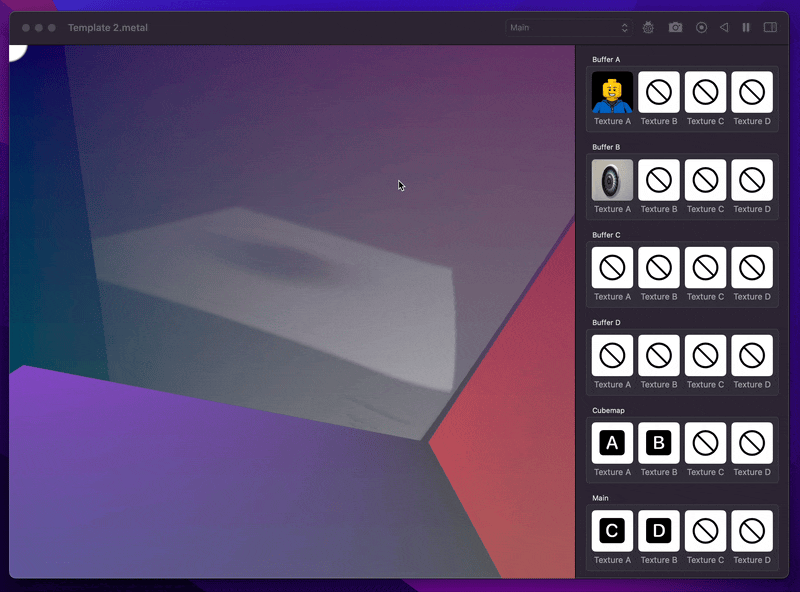The structure of are functions within the shader are based upon those from shadertoy.com but with a few differences:
The easiest way to start creating a shader is to use the template. This can be created from the ‘New from Default Template…’ option in the File menu. It will give you a default function for the main shader and the cubemap.
[[visible]]
half4 mainFragment(float2 fragCoord, constant FragmentUniforms &uniforms) {
half4 finalColor = half4(0,0,0,1);
// perform
return finalColor;
}
[[visible]]
half4 bufferA(float2 fragCoord, constant FragmentUniforms &uniforms) { // works for bufferA, bufferB, bufferC, & bufferD
half4 finalColor = half4(0,0,0,1);
// perform
return finalColor;
}
[[visible]]
half4 mainCubemap(float2 fragCoord, float3 rayOrigin, float3 rayDirection, constant FragmentUniforms &uniforms) {
half4 finalColor = half4(0,0,0,1);
// perform
return finalColor;
}
Each of the render methods are provided a uniform struct of values with contains the inputs and textures.
struct FragmentUniforms {
float time; // the current time through the render in seconds
float timeDelta; // the time it takes to render the last frame, in seconds
float frameRate; // currently pinned to 60
int frame; // the count of the current frame
int4 date; // the date as year, month, dat, and time in seconds as the .xyzw
float2 resolution; // the resolution of the viewport
float4 mouse; // the current mouse position on the viewport as .xy, and the position a left click started as .zw
float4 textureMediaTimes; // the times of media for each of the four textures in the x, y, z, & w values. 0 if not applicable.
texture2d<half> textureA; // the texture in slot A. If not set in the app it is a default missing-texture appearance.
texture2d<half> textureB; // the texture in slot B. If not set in the app it is a default missing-texture appearance.
texture2d<half> textureC; // the texture in slot C. If not set in the app it is a default missing-texture appearance.
texture2d<half> textureD; // the texture in slot D. If not set in the app it is a default missing-texture appearance.
texturecube<half> cubemap; // the texture created by the cubemap function. A black texture if not implemented.
};
These need to be defined at the top of the metal file being rendered and are automatically included in the template file for the shader.
Much like shadertoy it has the functionality to pass four textures (and a cubemap) to each of the rendering stages. These can be the output buffer of one of the render stages, an image, a frame of a video, a texture with states of keyboard key presses, or the webcam.
These can be specified independently for each stage allowing stages to be changed together.
When launched, the default output render is the main fragment but it is possible to change to view the output of each buffer, view them all mixed togethor, and also view the output of the cubemap as either a cubemap or as a equirectangular.
